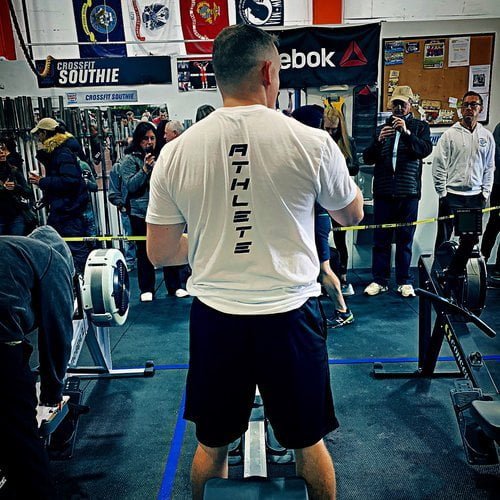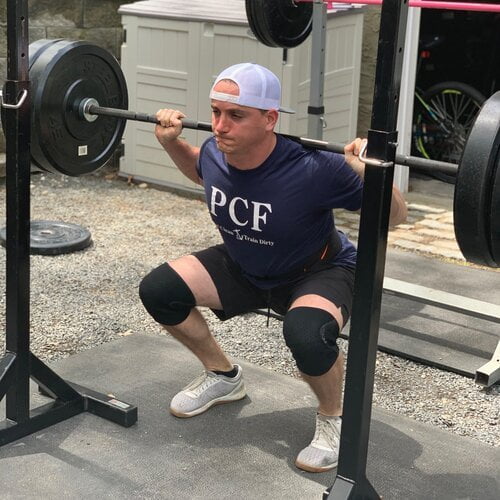The #1 CrossFit Nutrition Guide For Performance
In CrossFit, success is not just about giving 100% effort to your WOD (Workout of the Day); it’s also about giving your body the fuel it needs to perform at it’s best.
Proper CrossFit nutrition is critical for workout performance.
Whether you’re trying to train at an elite level, survive a grueling EMOM (Every Minute on the Minute) for the day, or improve your overall health – nutrition is your foundation.
If you do have performance goals, however, the right foods at the right times can be the difference between finishing strong or hitting the wall halfway through a workout.
This is where nutrient timing comes into play.
For CrossFit athletes, proper nutrient timing means strategically planning what to eat before, during, and after a WOD to optimize energy levels, enhance performance, and accelerate recovery.
Knowing how to fuel your body outside of simple caloric intake will help you perform your best during your training and recover more quickly for your next one.
In this article, we’ll move beyond common nutrition plans such as the Zone diet or Paleo diet and break down everything you need to know about a pre-, during-, and post-workout nutrition plan.
With detailed strategies for each phase so you can unlock your full potential and become one of the fittest athletes in your CrossFit gym.
**Please remember that nutrition is highly individualized. The recommendations below are based on peer-reviewed evidence and how I guide my nutrition coaching clients after a full assessment. Thus, they may not best suit your specific needs. Please consult a healthcare professional before incorporating the recommendations below into your diet.**
1. Pre-Workout CrossFit Nutrition: Fueling Up for the WOD
Why It Matters
The fuel you put into your body before CrossFit workouts can have a huge impact on how well you perform.
CrossFit is known for its high intensity—whether you’re powering through a high-rep barbell workout or sprinting through a cardio-heavy circuit, your body needs to be ready.
Pre-workout nutrition helps ensure your muscles have enough glycogen (stored energy) to power you through your WOD while preventing muscle breakdown during tough sessions.
Carbohydrates
Carbohydrates are your body’s preferred energy source, especially for the intense workouts found in CrossFit.
Eating the right amount of carbs before your workout ensures your glycogen stores are topped up, giving you readily available energy to perform at your best.
- Guidelines: Consume 1-4 g/kg of body weight of carbohydrates 1-4 hours before your WOD. (1)
The amount you need will depend on the intensity and duration of your workout, as well as your body weight. (1) - Example Foods: Oatmeal, sweet potatoes, bananas, rice, or whole grain bread.
- Timing: For optimal digestion and energy release, aim to eat your pre-workout meal 2-3 hours before training.
This allows your body to process the nutrients and convert them into energy in time for your WOD. (1)
Protein
Protein plays a key role in supporting muscle repair and growth, and consuming protein before a workout can help reduce muscle damage caused by intense exercise.
Including a moderate amount of protein in your pre-workout meal can also kickstart muscle protein synthesis, which is vital for recovery post-workout.
- Guidelines: Aim for 0.3-0.5 g/kg of body weight of grams of protein in your pre-workout meal to support muscle maintenance and prevent breakdown. (1)
- Example Foods: Lean meats such as chicken breast, eggs, Greek yogurt, protein shakes, or tofu are suitable for plant-based athletes.
Hydration
Hydration is just as critical as the food you eat.
Dehydration can quickly sap your energy and negatively impact your performance, especially during long or intense WODs.
Ensure you’re drinking water throughout the day, and sip water leading up to your workout.
- Recommendation: Drink at least 16-20 ounces of water 2-3 hours before the workout, and sip an additional 8-10 ounces about 30 minutes before you start. (1)
You can also add electrolytes to your water to support hydration, particularly in hot or humid conditions.
2. During-Workout CrossFit Nutrition: Sustaining Energy Levels
When It’s Necessary
For most CrossFit WODs, which tend to last less than an hour, intra-workout nutrition isn’t usually required. (1)
However, keeping your energy levels up becomes critical when you’re taking on longer sessions, like an endurance-focused Hero WOD or a competition that involves back-to-back events.
If your workout extends beyond 60-90 minutes, intra-workout nutrition can help maintain your performance and prevent fatigue from setting in.
Carbohydrates
During extended WODs, your body starts depleting glycogen stores, which can lead to a noticeable drop in energy and performance.
Consuming carbohydrates during your workout helps replenish glycogen and maintain blood sugar levels for energy production, allowing you to sustain your intensity throughout.
- Guidelines: For WODs lasting 1-2.5 hours, aim to consume 30-60 g of carbohydrates per hour. (1)
If your workout exceeds 2.5 hours, you can increase this to up to 90 g/hour. (1) - Example Products: Sports drinks, energy gels, or easily digestible fruits like bananas or oranges provide quick and effective sources of carbohydrates.
Hydration
CrossFit’s intensity, especially in hot or humid conditions, means you’ll lose a significant amount of fluid through sweat.
Staying hydrated is crucial for maintaining performance, avoiding cramps, and keeping your focus sharp.
Dehydration can lead to a rapid drop in energy levels and muscle function, so it’s essential to monitor your fluid intake.
- Guidelines: Aim to drink 0.4-0.8 L of fluid per hour during long workouts, adjusting based on your sweat rate.
If you’re sweating heavily, you’ll need more fluids to maintain hydration. (1)
Importance of Electrolytes
When you sweat, you lose more than water—you also lose key electrolytes like sodium, potassium, and magnesium.
These electrolytes are critical for muscle function, nerve signaling, and overall performance.
Without enough electrolytes, you may experience fatigue, muscle cramps, or even dizziness, so it’s important to replenish them during long workouts.
- Tip: Add an electrolyte supplement to your water, or use a sports drink that contains electrolytes to help maintain your body’s balance and keep your muscles firing on all cylinders.
3. Post-Workout CrossFit Nutrition: Maximizing Recovery
The Anabolic Window – Myth or Fact?
You’ve probably heard of the “anabolic window”—a supposed brief window of time after exercise when you need to refuel to maximize muscle repair and recovery.
While there is some truth to this, research shows that the timing is not as crucial as we once thought.
The focus should be on the overall daily intake of nutrients, particularly if you’re hitting your protein and carbohydrate goals regularly throughout the day.
However, eating soon after your WOD can still help kickstart recovery and get you ready for your next session.
Carbohydrates
After a tough WOD, your muscles are depleted of glycogen, and replenishing those energy stores with high-glycemic carbohydrates is crucial for recovery, especially if you have another workout planned soon.
The post-exercise period is the most effective time for glycogen resynthesis, and consuming carbohydrates quickly after a WOD can help your body bounce back faster.
Carbohydrates post-training help with hormone production to increase insulin levels and shift the body from a catabolic state (breakdown) to an anabolic state (building).
- Guidelines: To maximize glycogen resynthesis, consume 1.0-1.2 g/kg of carbohydrates per hour for the first 4 hours post-WOD.
This is especially important if you have less than 8 hours between training sessions. (1) - Example Foods: White rice, pasta, sweet potato, or recovery shakes that include carbohydrates are great options for replenishing glycogen quickly.
Protein
Protein plays a crucial role post-WOD as it is pre-WOD, particularly for stimulating muscle protein synthesis.
Consuming protein after a workout helps repair muscle fibers that were broken down during exercise and promotes the growth of new muscle mass.
The goal is to give your body enough amino acids to kickstart the recovery process.
- Guidelines: Ingest 0.25-0.3 g/kg of protein (about 20-40 g) within 0-2 hours after exercise to support muscle growth. (1)
- Example Foods: Fast-digesting protein sources like protein powders, lean proteins like chicken or turkey, lean beef, eggs, or plant-based proteins such as tofu or tempeh.
Hydration
Rehydrating after your WOD is just as important as before and during.
After intense sweating, your body needs not only water but also electrolytes to restore balance.
This is particularly vital for athletes training in hot environments or those who sweat heavily during workouts.
Rehydrating properly can speed up your recovery and ensure you’re ready for your next session.
- Recommendation: After your workout, aim to consume 16-24 ounces of water for every pound of body weight lost during exercise, and make sure to include electrolytes, especially if your workout was long or intense.
4. Special Considerations for CrossFit Athletes
Meal Frequency
It’s important to consistently supply your body with protein to optimize muscle protein synthesis (MPS) and maintain muscle recovery throughout the day.
Eating protein-rich meals every 3-4 hours ensures a steady flow of amino acids to your muscles, promoting continuous recovery and adaptation from your workouts.
This frequent intake keeps your muscles in a state of positive protein balance, which is essential for CrossFit athletes who want to maximize strength gains, recovery, and overall performance.
- Guidelines: Aim for 0.25-0.40 g/kg of protein per meal, spread evenly across the day. This could be 20-30g of protein per meal for most athletes. (2)
- Example Foods: Chicken, turkey, eggs, cottage cheese, or plant-based options like lentils or tempeh.
Pre-Sleep Nutrition
Recovery doesn’t stop when you sleep.
To enhance muscle recovery overnight, consuming 30-40 g of casein protein before bed can boost muscle protein synthesis during sleep. (2)
Casein is a slow-digesting protein found in dairy products, which means it releases amino acids steadily throughout the night, keeping your muscles supplied with nutrients for repair and growth while you rest.
This is particularly beneficial for CrossFit athletes training multiple times per week or those aiming to build muscle.
- Recommendation: A serving of casein protein powder, a glass of milk, or Greek yogurt before bed can help ensure you’re maximizing overnight recovery.
Caffeine
Caffeine is well-known for its performance-enhancing effects when consumed before a workout, but it can also be beneficial post-WOD.
When paired with carbohydrates, 3-8 mg/kg of caffeine has been shown to enhance glycogen resynthesis, helping you recover faster. (2)
This can be especially useful for CrossFit athletes who have back-to-back training sessions or competitions where quick recovery is critical.
- Tip: Try having a small serving of caffeine, such as a cup of coffee or an energy drink, with your post-workout meal to help boost glycogen stores.
Wrapping Up On Nutrient Timing For CrossFit
In CrossFit training, getting the essential nutrients you need at the right time can significantly affect performance, recovery, adaptation to training, and reaching an ideal body composition.
Focusing on carbohydrates and protein intake before, during, and after your WODs can help you reach peak performance, delay fatigue, and enhance muscle recovery.
Whether it’s fueling up with carbs before a session, sustaining energy during long WODs, or optimizing recovery with post-WOD protein and carbs, nutrient timing is a powerful tool for improving CrossFit performance.
I hope this guide helps you fine-tune your nutrition, smash your fitness goals and reach your optimal performance during WODs.
Remember, every athlete is different, so experiment with your nutrient timing strategy and discover what works best for your body and individual needs to optimize both recovery and long-term CrossFit success.
References:
- Arent, S. M., Cintineo, H. P., McFadden, B. A., Chandler, A. J., & Arent, M. A. (2020). Nutrient Timing: A Garage Door of Opportunity?. Nutrients, 12(7), 1948. https://doi.org/10.3390/nu12071948
- Kerksick, C. M., Arent, S., Schoenfeld, B. J., Stout, J. R., Campbell, B., Wilborn, C. D., Taylor, L., Kalman, D., Smith-Ryan, A. E., Kreider, R. B., Willoughby, D., Arciero, P. J., VanDusseldorp, T. A., Ormsbee, M. J., Wildman, R., Greenwood, M., Ziegenfuss, T. N., Aragon, A. A., & Antonio, J. (2017). International society of sports nutrition position stand: nutrient timing. Journal of the International Society of Sports Nutrition, 14, 33. https://doi.org/10.1186/s12970-017-0189-4







